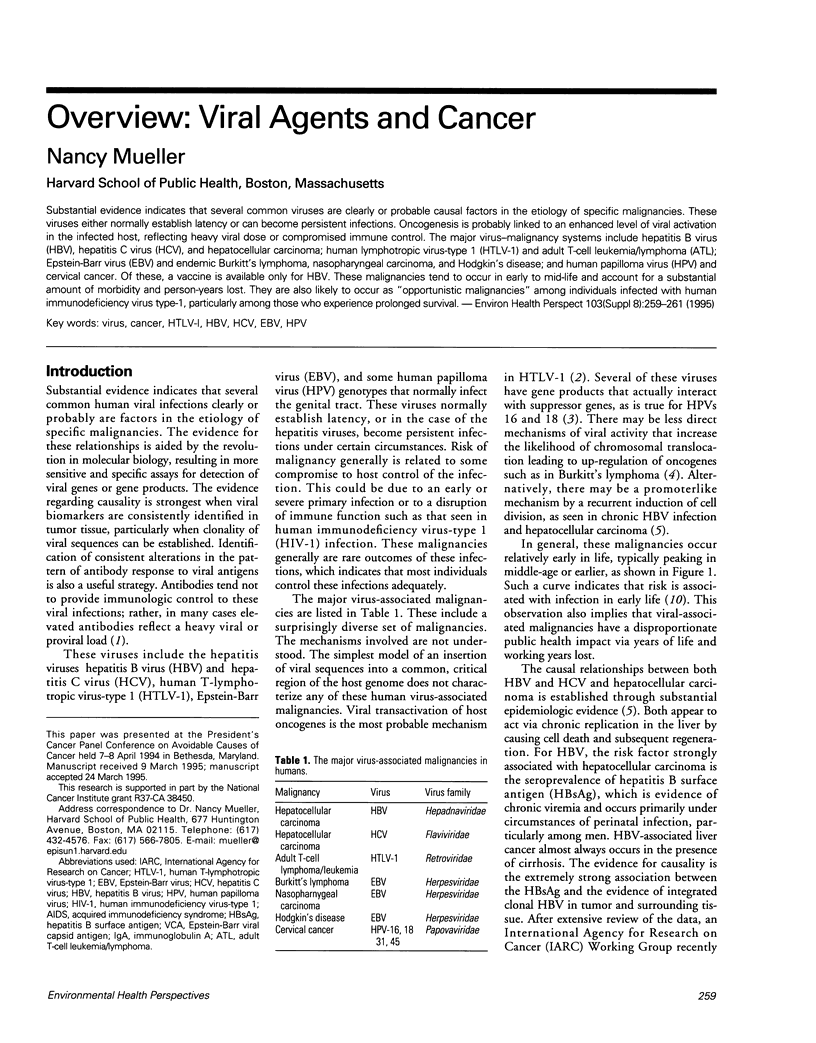Overview: viral agents and cancer (original) (raw)
Abstract
Substantial evidence indicates that several common viruses are clearly or probable causal factors in the etiology of specific malignancies. These viruses either normally establish latency or can become persistent infections. Oncogenesis is probably linked to an enhanced level of viral activation in the infected host, reflecting heavy viral dose or compromised immune control. The major virus-malignancy systems include hepatitis B virus (HBV), hepatitis C virus (HCV), and hepatocellular carcinoma; human lymphotropic virus-type 1 (HTLV-1) and adult T-cell leukemia/lymphoma (ATL); Epstein-Barr virus (EBV) and endemic Burkitt's lymphoma, nasopharyngeal carcinoma, and Hodgkin's disease; and human papilloma virus (HPV) and cervical cancer. Of these, a vaccine is available only for HBV. These malignancies tend to occur in early to mid-life and account for a substantial amount of morbidity and person-years lost. They are also likely to occur as "opportunistic malignancies" among individuals infected with human immunodeficiency virus type-1, particularly among those who experience prolonged survival.

Selected References
These references are in PubMed. This may not be the complete list of references from this article.
- Doll R. An epidemiological perspective of the biology of cancer. Cancer Res. 1978 Nov;38(11 Pt 1):3573–3583. [PubMed] [Google Scholar]
- Evans A. S., Mueller N. E. Viruses and cancer. Causal associations. Ann Epidemiol. 1990 Oct;1(1):71–92. doi: 10.1016/1047-2797(90)90020-s. [DOI] [PubMed] [Google Scholar]
- Galloway D. A. Papillomavirus capsids: a new approach to identify serological markers of HPV infection. J Natl Cancer Inst. 1994 Apr 6;86(7):474–475. doi: 10.1093/jnci/86.7.474. [DOI] [PubMed] [Google Scholar]
- Koutsky L. A., Galloway D. A., Holmes K. K. Epidemiology of genital human papillomavirus infection. Epidemiol Rev. 1988;10:122–163. doi: 10.1093/oxfordjournals.epirev.a036020. [DOI] [PubMed] [Google Scholar]
- Levine A. M. AIDS-related malignancies: the emerging epidemic. J Natl Cancer Inst. 1993 Sep 1;85(17):1382–1397. doi: 10.1093/jnci/85.17.1382. [DOI] [PubMed] [Google Scholar]
- Mueller N. The epidemiology of HTLV-I infection. Cancer Causes Control. 1991 Jan;2(1):37–52. doi: 10.1007/BF00052359. [DOI] [PubMed] [Google Scholar]
- Schiffman M. H. Recent progress in defining the epidemiology of human papillomavirus infection and cervical neoplasia. J Natl Cancer Inst. 1992 Mar 18;84(6):394–398. doi: 10.1093/jnci/84.6.394. [DOI] [PubMed] [Google Scholar]
- Schiffman M. H., Schatzkin A. Test reliability is critically important to molecular epidemiology: an example from studies of human papillomavirus infection and cervical neoplasia. Cancer Res. 1994 Apr 1;54(7 Suppl):1944s–1947s. [PubMed] [Google Scholar]
- Tajima K. The 4th nation-wide study of adult T-cell leukemia/lymphoma (ATL) in Japan: estimates of risk of ATL and its geographical and clinical features. The T- and B-cell Malignancy Study Group. Int J Cancer. 1990 Feb 15;45(2):237–243. doi: 10.1002/ijc.2910450206. [DOI] [PubMed] [Google Scholar]
- Williams E. H., Smith P. G., Day N. E., Geser A., Ellice J., Tukei P. Space-time clustering of Burkitt's lymphoma in the West Nile district of Uganda: 1961-1975. Br J Cancer. 1978 Jan;37(1):109–122. doi: 10.1038/bjc.1978.16. [DOI] [PMC free article] [PubMed] [Google Scholar]
- Wong M., Gruber J. Viral interactions with the p53 gene in human cancer: NCI workshop. J Natl Cancer Inst. 1994 Feb 2;86(3):177–182. doi: 10.1093/jnci/86.3.177. [DOI] [PubMed] [Google Scholar]
- de-Thé G., Geser A., Day N. E., Tukei P. M., Williams E. H., Beri D. P., Smith P. G., Dean A. G., Bronkamm G. W., Feorino P. Epidemiological evidence for causal relationship between Epstein-Barr virus and Burkitt's lymphoma from Ugandan prospective study. Nature. 1978 Aug 24;274(5673):756–761. doi: 10.1038/274756a0. [DOI] [PubMed] [Google Scholar]